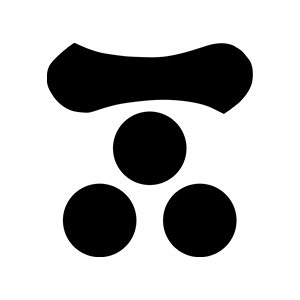Choshu Domain (1/2)A leading figure in the Meiji government

Mori family crest: ``One character with three stars''
- Article category
- History of the domain
- domain name
- Choshu Domain (1600-1871)
- Affiliation
- Yamaguchi Prefecture
- Related castles

Hagi castle ruins
- related castles
The Choshu domain began with Hidenari Mori, the son of Terumoto Mori, one of the Five Elders of the Toyotomi clan, and was ruled by the Mori family until the Meiji Restoration.
It became the center of the anti-shogunate movement, and gave birth to the leading figures of the Meiji Restoration, such as Shoin Yoshida and Shinsaku Takasugi, who believed in the idea of revering the emperor and expelling the barbarians, such as Takamitsu Kido, Masujiro Omura, Hirobumi Ito, Kaoru Inoue, and Aritomo Yamagata.
Let's unravel the history of such a tall clan.
The origins of the Choshu domain
The Choshu domain was established by reducing the territory of Mori Terumoto, the commander-in-chief of the Western Army, and limiting his territory to the two provinces of Bochogoku.
The Mori clan was founded by Mori Sumitsu, the fourth son of Oe Hiromoto, a senior vassal of the Kamakura shogunate.
Motonari Mori, the 12th generation pitcher of the Mori clan, elevated the Mori family from a single countryman to a feudal lord in the Sengoku period, and by the time of his grandson Terumoto Mori, he was among the top in the country with territories that included San'in, Sanyo, and even part of Kyushu. He grew to become a daimyo.
Terumoto Mori himself served Toyotomi Hideyoshi and was appointed one of the Five Elders.
At the Battle of Sekigahara, he was appointed commander-in-chief of the Western Army and was held accountable by Tokugawa Ieyasu.
Terumoto Mori had most of his territory confiscated and was forced to retire.
He was succeeded by his eldest son, Hidenari Mori.
Thus, the Choshu domain was established, and Hidenari Mori was appointed as the first lord of the domain, but since he was still a child, Terumoto Mori was in charge of the practical experiments of the domain.
Terumoto Mori entered Hagi Castle, which was under construction, in 1604 with the first lord of the domain, Hidenari Mori.
In addition, in 1610, the territory was again detected and the shogunate was declared to have 539,268 koku, but the shogunate reported that a revolt had occurred during the detection and that the lord of the neighboring Hiroshima domain Since Masanori Fukushima was a military commander who had made great achievements in the Eastern Army, and it was difficult to balance that, 70% of the declared koku, or 369,000 koku, was officially recognized as Omote koku, and this remained unchanged until the end of the Edo period. .
Choshu domain until the end of the Edo period
The first lord of the domain, Hidenari Mori, had a serious conflict with Hidemoto Mori, his father's adopted son and guardian, to the extent that the shogunate intervened.
His successor, Hidenari Mori's fourth son, Tsunahiro Mori, had a strong rebellious spirit and was ashamed of serving the Tokugawa family, so he even refused to go to Edo Castle even though he was in Edo.
As the second lord of the domain, Tsunahiro Mori played an effective role, building the Hagi Okan to connect Hagi and Mitajiri in Suo Province, and establishing the ``33 Articles'' law known as the Manji System Law. .
However, due to the persuasion of his vassals who feared his rebellious attitude towards the Tokugawa family, he retired in 1682 at the age of 43.
After that, the Mori family entered a period of short-lived feudal lords who died in their 20s or 30s.
Some of the feudal lords carried out flood control works or received poor performance from the shogunate, and as a result, the Choshu domain's finances gradually deteriorated.
In order to improve the domain's deteriorating finances, Shigenari Mori, the seventh lord of the domain, embarked on reforms to the domain's administration, including cutting costs, developing new fields, restoring devastated fields, and improving distribution through port construction.
As a result of these efforts, the Choshu domain developed as a port of call for shipping ships, increasing income through sales of domain goods, lending funds to shipping companies, and renting out warehouses.
Furthermore, we succeeded in obtaining income equivalent to 40,000 koku through detection.
On the other hand, due to the strict collection of annual tax, there were many uprisings, and the Choshu domain was forced to deal with them.
The 10th feudal lord, Mori Saihiro, strengthened naval defense and military armaments using Western armaments, but in 1836, during the time of his successor, the 11th feudal lord, Mori Saimoto, the Choshu domain was designated as a A large-scale flood called "The Great Flood" struck. Two-thirds of the castle town was submerged in water, and more than 200 people were killed. While dealing with the disaster, Mori Narimoto himself passed away.
Under these circumstances, Takachika Mori became the 13th lord of the domain. (The 12th generation died at the age of 23 just 20 days after taking over.)
Choshu domain at the end of the Edo period
Takachika Mori was born as the eldest son of Narimoto Mori, but neither of them came from the Mori family, but from the Fukuhara family, one of the eight hereditary chief retainer families.
As a recovery measure from the Great Flood of the Year of the Monkey, we adopted frugality and reformed the circulation of money.
- related castles

- WriterAYAME(Writer)I am a writer who loves history, focusing on the Edo period. My hobbies are visiting historical sites, temples and shrines, and reading historical novels. If there is a place you are interested in, you can fly anywhere. I'm secretly happy that the number of sword exhibitions has increased recently thanks to the success of Touken Ranbu.



